You passed through several experiences of teaching in different schools of Belgium. What led you to this career interest? Can you also describe your actual teaching experience as a professor at La Cambre (École nationale supérieure des arts visuels).
David Marlè (DM): Well, my grandparents were both teachers, my father was a schoolteacher, this is a sort of family tradition … Let’s say they gave me the goodwill, or at least, a primary value to their eyes: intellectual curiosity. In teaching we learn a lot: about yourself first, it is not enough to know a material to transmit it, it must be digested, integrated, it has to became a part of yourself first. Giving courses requires me to clarify my knowledges, to prioritize them and give them a form suitable for transmission. Secondly, it asks me to remain alert, both curious and critical, towards the more and more sophisticated tools that we use, and towards the multiple evolutions of photography and contemporary art.
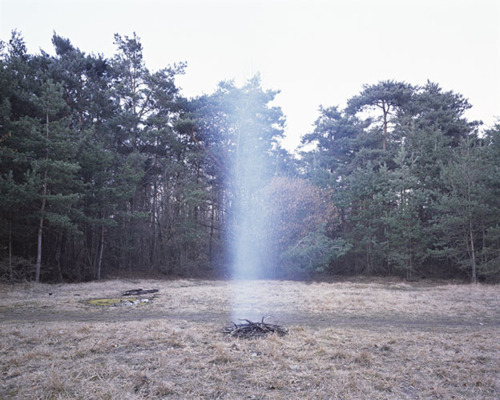
© David Marlé from the series 'Collection/Rehearsal'
Then this it is not a one way activity, you inter-react with photographers in the making: some talented, some less, but all driven by the same fever and I particularly like the mental gymnastics that it entails: we must push each student to develop themselves to their full potential, and that means understanding the other, help him to build a critical look at his own work, to contextualize his evolution in the history of art, to support him, and also destabilize him, allow him to go wrong … finally, it comes to saving some lifetime for the student, make him travel in 5 years through the experiences who would have taken 10 or 15 years to a self-taught. Explained like that, it desecrates a bit the aura of a professor, but I absolutely do not believe in the one-sided teachings from master to student, the result is too often a generation of young photographers more or less skillfully imitating their teacher.

© David Marlé from the series 'Collection/Rehearsal'
At la Cambre, I found a balance that is precious to me: I teach one afternoon a week: enough for leading a serious work, but not enough to discourage me when the work does not progress and certainly not enough for me to feel jaded. I remain very excited about teaching! I try to keep in mind this image of the transmission of knowledge as a virus, you have to almost physically contaminate those around you with photography. It’s also a game, and you always try to win the game, to see every young photographer realizing himself, then we cheat, we try the charm, the best rhetoric, the most valuable arguments or some brilliant explicit metaphors… everything needed».

© David Marlé from the series 'Collection/Rehearsal'
You are also a Fine Art Printer at the Atelier KZG. Could you tell us about it? How in your opinion we can facilitate in today’s visual society a more conscious, if not critical, approch to images.
DM: I did a lot of different jobs in photography, from pack-shot to architectural photography, shooting exhibitions, art reproductions or a little bit of documentary. I’ve even been specialized in car photography for two years. But from a certain point of view, it is always the same thing: it doesn’t matter if you are photographing a pretty girl, a painting, some furniture, a car or a landscape, it’s still only made up of shapes and colors arranged together that has to be organized in a two-dimensional representation, and a perspective of author that needs to be added. Being an inkjet printer for artists is about building images as it’s done in commercial photography: understanding the desires or the intentions, sometimes abstract, not really explicit or even remaining unsconcious, and find the best suited solution to a visual translation of these ideas or concepts. For this, much dialogue with the photographer is essential, and gradually the confidence and greater mutual understanding has to be settled. To enhance this way of working we call “slow maturing” of the image, we work just like our predecessors in silver prints: during a first appointment with the photographer, we define together what the perfect print should look like, then a second appointment with some test strips is used to refine the color balance, the density, the contrast and the grain, all the enhancements which have to be made. The appointments follow until we agree and get ready to launch the print or the series. That’s quite intimate and in fact, we’re lucky to get into the head of very different photographers, to share their developments, their doubts, to try to find solutions with them, and then to see the exhibition or the book … and start over.
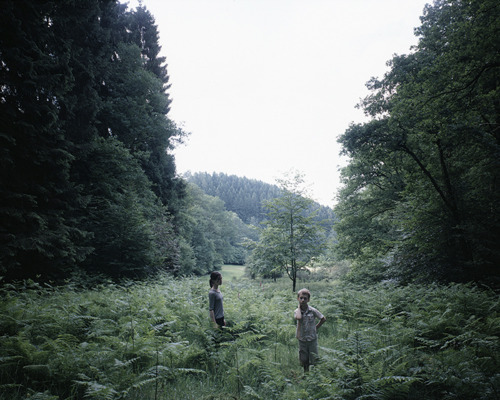
© David Marlé from the series 'Collection/Rehearsal'
I am not certain that we can bet on a positive trend in the ability of image analysis by the general public. The image is increasingly hybridized, multiple, and more and more studied from a technical point of view as well as from a theoretical one than ever, for sure, but it affects a culturally privileged part of the society. The vast majority of viewers have seen the flow of images being demultiplicated, and the time of vision being shortened to barely perceptible. In addition, the different medias relaying the image have made us used to poor quality as much as a fierce zapping, and this does not argue in favor of a more conscious viewing, but rather to a Pavlovian reflex behaviour. I discovered a few months ago a luxury magazine where the images were printed at 72 dots per inch: all curves of the images were stairs and, showing it to friends, I realized that no-one was paying attention to this detail unless I was telling them.
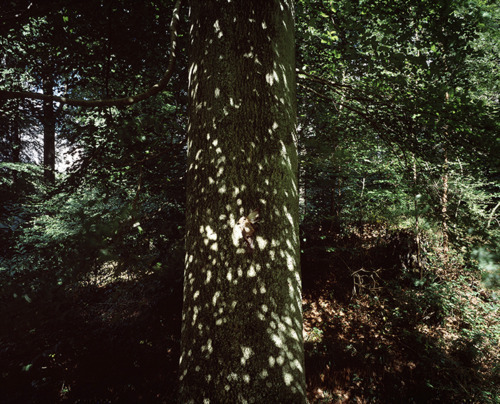
© David Marlé from the series 'Collection/Rehearsal'
We live in a time of specialists, each practice has its own dialect, its codes and icons: photographers are no exception to the rule. We now have very thorough analytical tools and references, museums, foundations and galleries, bedside books, philosophers and historians of photography, but these are tools that require a specific culture for use and are part of a general literacy level, or even taught in school (although László Moholy-Nagy said in 1928: “The illiterate of tomorrow will be the one who will not read a photograph” in the Petite Histoire de la Photographie, Walter Benjamin).
But it does not matter, in the other hand, the photography is full of undiscovered fields. There is still a lot to do. The images (I mean, the object, the technique…) do not interest me as much as what they ultimately express: research, ideas, concepts, or emotions. On that side I’m very positive: there are a thousand ways to make that grow, everyone finds a way to use the images. Photography is an accessible medium, as shown by the family albums, the press pictures or in social networks… but also made by more and more amateurs (in the sense of “who loves it”). That’s the good part of this continuous stream of images: they are totally desecrated, and ready to do what we want. Open images, available to all. It is as if the photographers are finally catching up the ability of the artists to nimbly seize all media for their inner qualities.
Obviously, we must continue to fight against many ideas such as: “real photography”, "photography is truth", “photographs in black & white, that’s art”, or also the common idea that anyone can make a good photograph: that does not mean a photographic work! The confusion and distinguishing nature between “nice pic” and “good image” that still remains to explain…
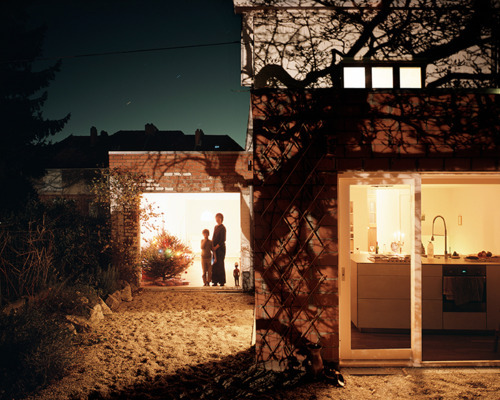
© David Marlé from the series 'Collection/Rehearsal'
This series of interviews features teachers as well as schools. Can you describe the photography program at La Cambre. What seems to be students of today’s expectations. Which drivers are embraced and engaged to create a dynamic environment for teaching and, for students, a remarkable place to study photography?
DM: La Cambre is seventeen options as diverse as animated cartoon, fashion, conservation and restoration of art, sculpture, drawing… The teaching is divided between a general core and the artistic practice inside a medium-specific option. The richness that I found when I was a student was to me due to the mix between a well defined practice and an extremely open world of possibilities. At once a school of photography yet within in an art school: where I found a very practical focus but quite contextualized and enriched by the other art fields. Boundless energy also: many emulations around projects, a lot of meetings, and immense resources in all areas of expertise.

Student work: Virginie Gouband - Flash 01
Here and now the photography studio (option) is based on a trial / error method with these few major goals : practice, practice, practice, being autonomous as soon as possible, experiencing everything, developing a particular reflection on the medium and a personnal vision of the world. The five years leading to a master degree in photography are articulated around three grand objectives:
a. The apprenticeship of technique : the formation includes the techniques and know-how that is the object of an apprenticeship in the studio courses and of an empirical apprenticeship. The student is pushed to understand the wide scope of these techniques, is informed as to the basics and usage of tools for the development of the artistic project.
b. The praxis: to guide the student in his daily photographic activity using a pedagogy of evolution, articulating around action and reflection through projects. The student is led to practice photography based on themes proposed by the teachers. He conceptualizes, realises, and defends his projects in front of a group and during individual readings.
c. Creating autonomously: The goal of the department is to help the student to transform his knowledge into a personal way of working. He has to develop a proper manner of understanding, perception, and to manage the system of explanation of relations between inner thought and the outside world. It is the conscience area of “doing” and its purpose, a kind of “birth of conscience”.
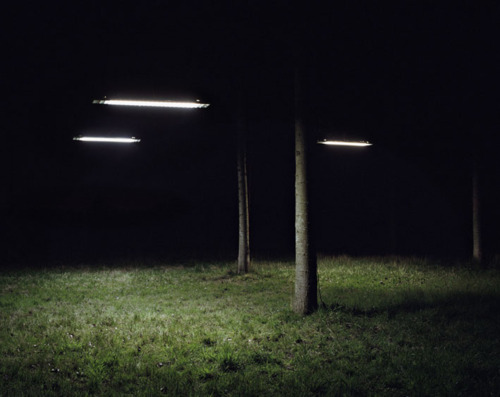
Student Work: David De Beyter - ‘Sans Titre’ (2008)
Above and beyond guidance inside the studio, the confrontations are organized in centripetal manner, by an opening to the actors in the world of art (seminaries, invited professionals, artists, photographers, gallery directors, museum directors, artists’ studios, schools…). The inter-disciplinary aspect of La Cambre, characterized by its common courses to students in the entire school and by its training courses within other departments, is particularly encouraged.
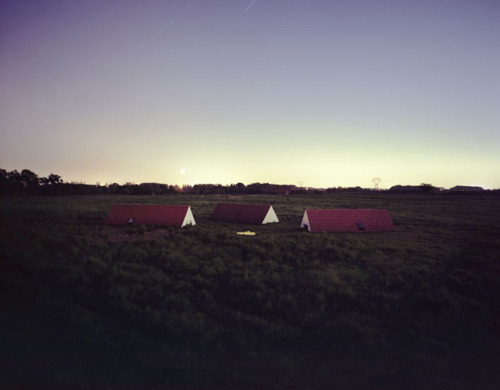
Student Work: David De Beyter - 'Sans Titre’ (2009)
The first three years are devoted to the discovery, exploration and maximum experimentation, more on techniques than on genres. First wandering around in all the functions and types of photography, students learn by confrontation, always driven by constructive criticism and pushed towards a greater conceptualization of the project and a better analysis of the images produced.
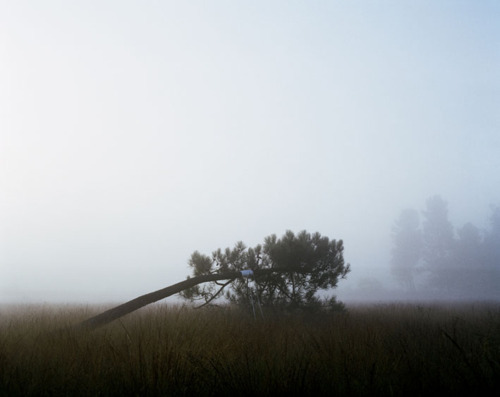
Student Work: David De Beyter - 'Sans Titre’ (2008)
The last two years focus on research and the personnal project of the student: they are creative years in which students learn to locate their actual practice in the historical and contemporary photographic production. Then comes the assertion of an artist position and the developement of a personal standpoint, as far as the finalization of the project (how to show the work, how to exhibit it, the production of theoretical texts, the insertion in the chain of production and in the art network).
Today’s student expectations ? They are hungry, curious, open-minded, they are the generation of “sampling” in music, they re-use, they mix, they quote freely… open-source artists ! I think they’re looking for some help iin structuring this magma at their disposal, tools to enable them to organize their thoughts, and being assured of the freedom to use the know-how and concepts as they please. They want to save time, learn from their elders without having to imitate them».
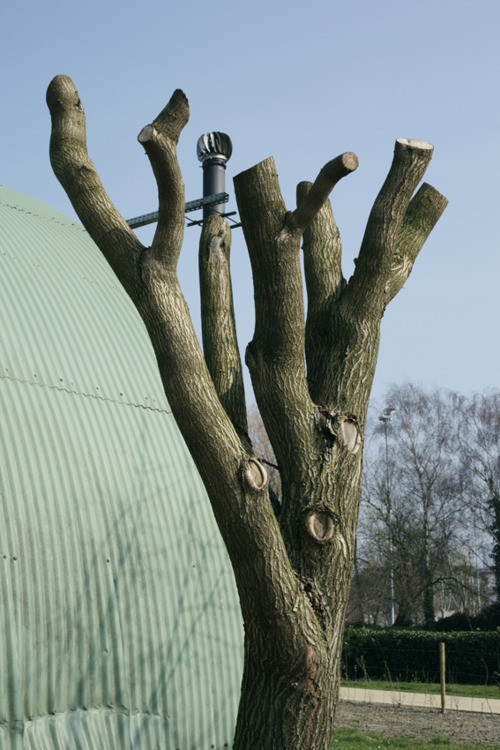
Student work: Zoe Van Der Haegen - 'Battlefield 01’
What about your artistic paths and photographic research?
DM: I became more and more multi-tasking, time is very precious to me, I do not get enough. I am a very slow photographer, I must see a lot of exhibitions, much reading, listening to music, watch theater or dance pieces, and then live and think again before I am able to do some pictures. I have some handbooks of pictures to do, that I am copying from one to the other trying to sort my ideas.
The issues that obsess me now revolve around the relationship between human activities and the altered landscape, the representations of the nature in the history of art, the question of the point of view, (“When a painter or a writer introduces characters in a landscape or near a monument, it is not a way to choose an accessory. The characters are giving the scale and, more importantly still, they introduce possible points of view that add to the real point of view of the observer some essential potentialities. "Michel Tournier, Vendredi ou les limbes du Pacifique), and how the landscape is examinated and used by Science to understand or rebuild the past.

© David Marlé from the series 'Collection/Rehearsal'
'Collection / Rehearsal' is a body of work build around the principle of collecting, that is to say, working like a butterfly catcher. First, stay alert and ready to capture whatever you gonna meet, intuitively, regardless of good or bad subjects. Then work on it, categorize it and prepare for the viewer the more significant images you can extract from these experiences. Extrapolate from the personnal level to a more significant one. These are just scenes of contemporary life, gestures that challenge me, some recurrences in my daily life that occurs often, or places I go through with enough suggestive possibilities. You’ll find there are trivial times, some climax and many in between moments.
Underneath there is the idea, (from Nietsche) that the man needs to realize his own given power, and if you look closely to the environnement of the human beeing, you can see many clues of that spent energy left behind.

© David Marlé from the series 'Collection/Rehearsal'
And finally, it’s also about a form of internal collapse, a kind of silent slip that sometimes we are the prey, as an insidious lag between sound and image in a foreign movie with doubled voices, as when we speak with a plugged ear, a slight delay in consciousness. The Process is somehow always similar: Each of my photographs is first of all a missed snapshot. So fleeting, I see (or I guess) what could be a photograph. I keep from these "snapshots” a very unfaithful memory that I use later as a basis for developing an image. Then you have to really work: make some research on the subject, scouting some locations and starting building this mental image until I can implement it.
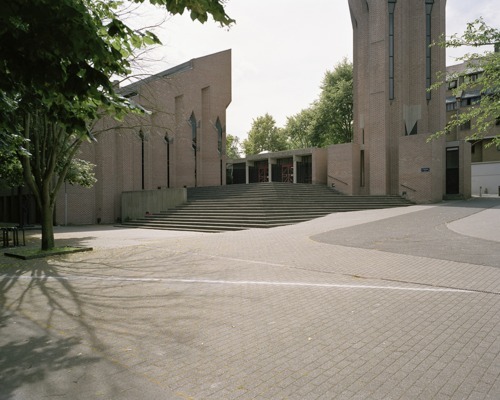
Student work: Maxime Brygo - 'In Europe / Plateaux brabançon et hesbignon’ (2010)
I don’t want to testify on a particular or a personal reality. What really interests me are the images with a wide implicit meaning : trying to communicate a diffuse feeling, or a complex idea in the form it could have taken before a literate or a verbal formulation of it. Show something in a pre-verbal perception form. Rudolf Arnheim was saying “The essence of an image is its ability to convey meaning through sensory experience”, this is how I conceive that we can perceive my images and also how I built those as direct interfaces with the viewer».
What are your working at and what are your plans for the Future?
DM: I’m working on this endless project 'Collection / Rehearsal’, I am also preparing something that may be called 'Disquiet Portraits’ That will be portraits of people obsessed by one of their activities, mostly artists. I want to make a picture of an avalanche, of the maelström, an image of Eve, etc …
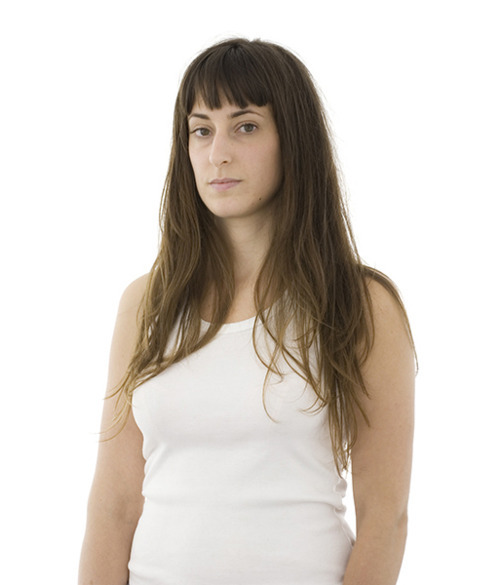
© David Marlé from the series 'As we are'
How do these match with your teaching activities?
DM: There is no direct connection, but without this practice, I would be unable to renew myself, and teach my knowledge, but also my hesitations, my doubts. Being active in the art world also creates many opportunities to invite photographers or artists to come and meet our students, to participate in their upcoming jury…
Tell us about the series Collection / Rehearsal. How you put together different extracts of memories? How landscape photography has evolved from your perspective?
DM: I am using a field camera to build these photographic views. The process is similar to the work of the painter working from his memory; putting together scenes, places, lights and acts that he has met at different moments in time. In a specified point of view, I will make several pictures to get different lights and many interactions between the people who are photographed. Then the image will be produced in a composite way, trying to concentrate space and time in a single and particular bi-dimensional representation. So these images were not made (drawn) by nature, but by memory, or to say it differently, were not captured but were composed. Shooting is a very dense moment for me, once I have all set up, I just need to have the most focused look to the scene, waiting for small changes, and non-spectacular actions happening.
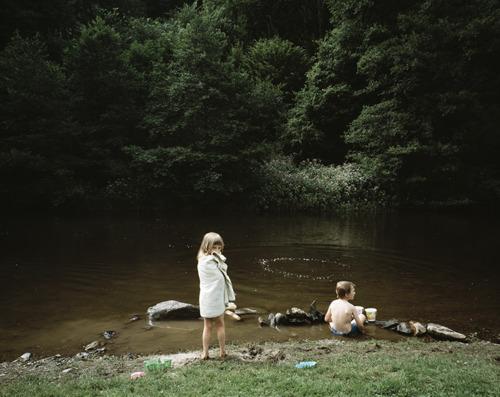
© David Marlé from the series 'Collection/Rehearsal'
The final object is a pigment print on cotton paper, 150x180 cm, it’s a very accurate and fully detailled picture with different way of seeing it according to the distance of the viewer. The series is a kind of painting collection, there is no order ot narration, there is rather a coexistence of images, a mutual reinforcement of their similar sense. Every new exhibition leads me to make a new choice in these images in accordance to the exhibition space and with the curator.
---
LINKS
David Marlé
Belgium
share this page